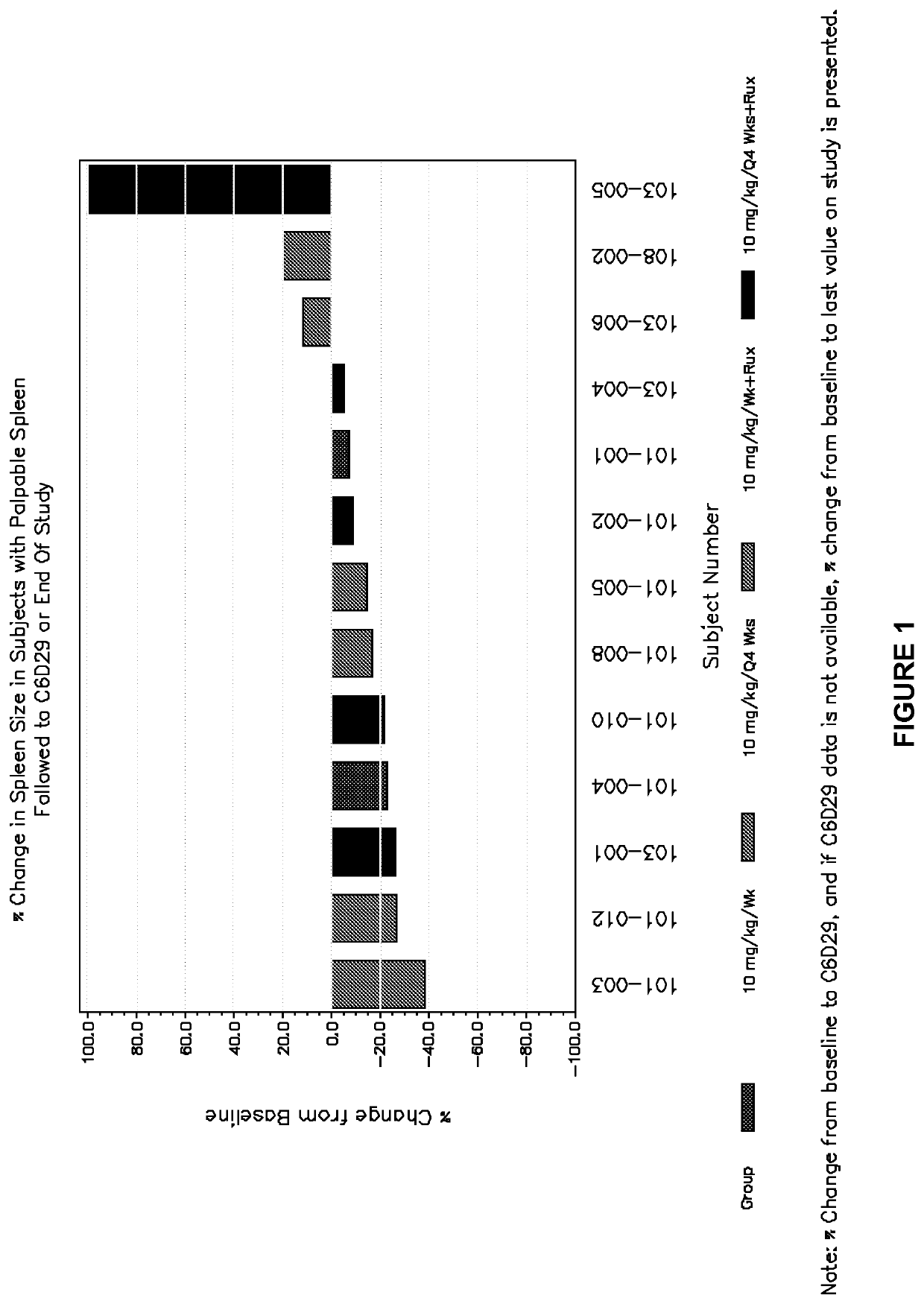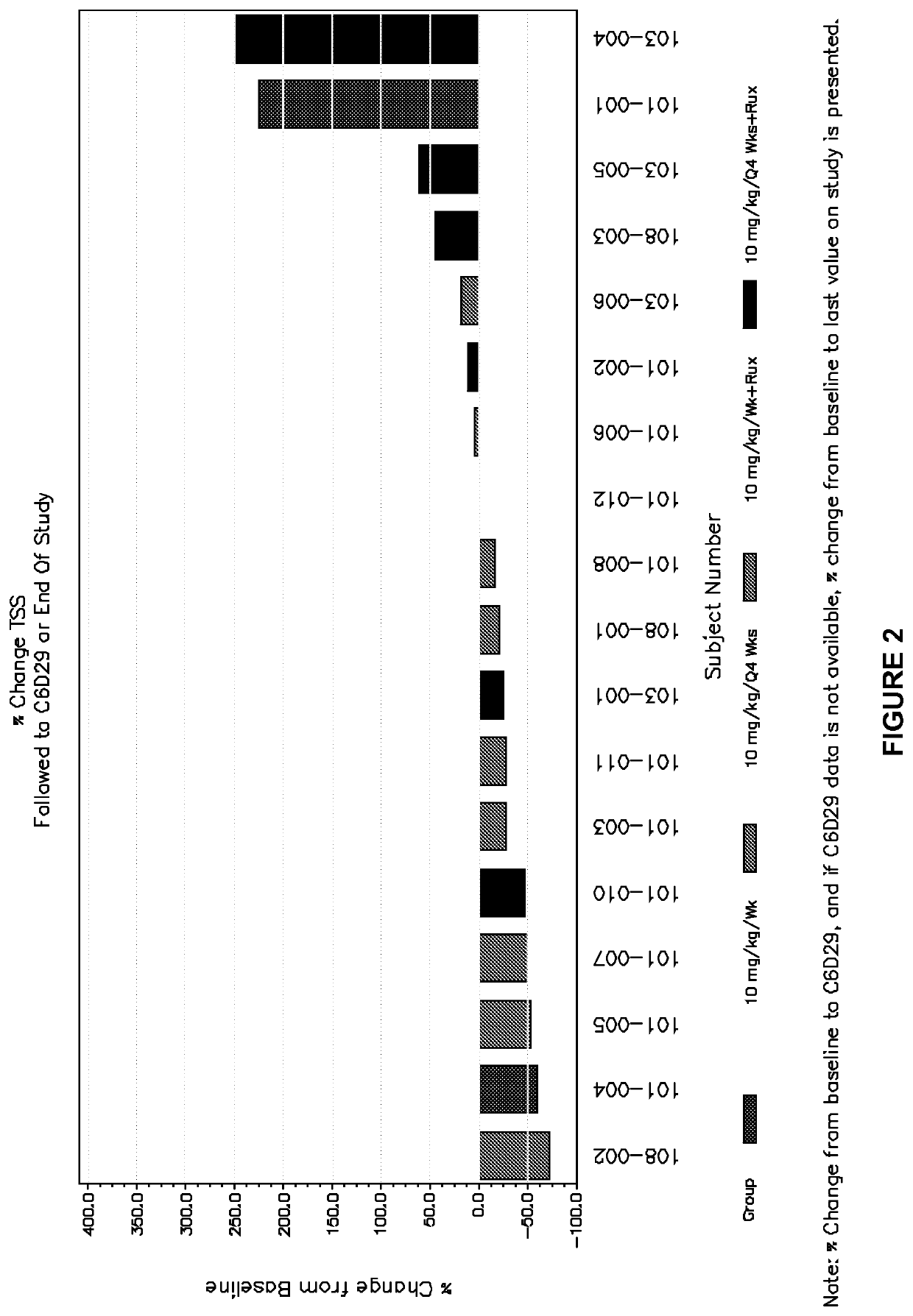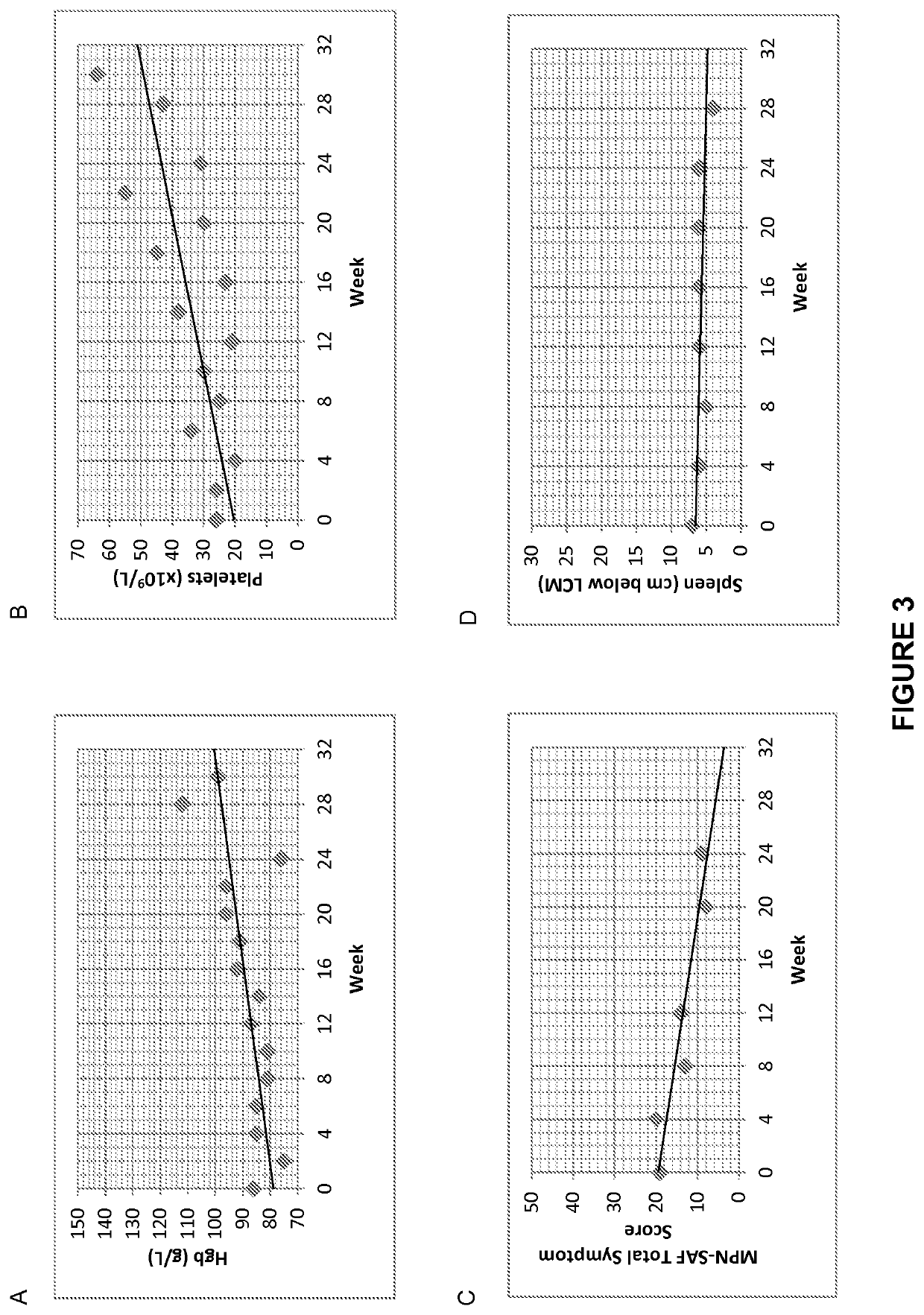[0011]In some embodiments, the SAP polypeptide is a fusion protein comprising an SAP domain and one or more heterologous domains. In some embodiments, the one or more heterologous domains enhance one or more of in vivo stability, in vivo half-life, uptake / administration, tissue localization or distribution, formation of protein complexes, and / or purification.
[0015]In some embodiments, the anti-cancer therapeutic is selected from: chemotherapy agents, antibody-based agents, tyrosine kinase inhibitors, immunomodulatory agents, biologic agents, and combinations thereof. A single additional agent or multiple additional agents or treatment modalities may be co-administered (at the same or differing time points and / or via the same or differing routes of administration and / or on the same or a differing dosing schedule). In certain embodiments, treatment with the SAP agonist improves the safety and / or efficacy and / or reduces one or more side effects of the additional anti-cancer therapeutic, relative to that experienced when the additional anti-cancer therapeutic is administered in the absence of the SAP agonist. In certain embodiments, prior to addition of the SAP agonist, a patient (the patient in need of treatment) is unresponsive or resistant or refractory to, or the patient is receiving a suboptimal or declining benefit from treatment with the anti-cancer therapeutic, and addition of an SAP agonist to the therapeutic regimen results in increased clinical benefit due to the SAP agonist and / or improves responsiveness of the additional anti-cancer therapeutic. In certain embodiments, treatment with the SAP agonist is such that the additional anti-cancer therapeutic can be administered at a different dose than that recommended when the additional anti-cancer therapeutic is administered alone, for example, the anti-cancer therapeutic can be (or is) administered at a lower dose or at a higher dose. This difference in dose can be assessed relative to a specific patient's regimen or relative to the recommended dose or dose range. In certain embodiments, the SAP agonist comprises an SAP polypeptide, such as a glycosylated SAP polypeptide, such as a glycosylated SAP polypeptide having glycosylation that differs from human SAP purified from serum. In certain embodiments, the combination of an SAP agonist and the additional anti-cancer therapeutic is indicated for a condition, patient population or sub-population for which the additional anti-cancer therapeutic alone is not indicated.
[0017]In some embodiments, the antibody-based agent is selected from but not limited to: alemtuzumab, bevacizumab, cetuximab, fresolimumab, gemtuzumab ozogamicin, ibritumomab tiuxetan, ipilimumab, ofatumumab, panitumumab, rituximab, tositumomab, trastuzumab, trastuzumab DM1, and combinations thereof. In certain embodiments, the method comprises administration of the SAP agonist and an additional anti-cancer therapeutic, which additional anti-cancer therapeutic is an antibody-based agent. In certain embodiments, the SAP agonist comprises an SAP polypeptide, such as a glycosylated SAP polypeptide, such as a SAP polypeptide having glycosylation that differs from human SAP purified from serum. In certain embodiments, the patient in need of treatment is a patient having a cancer that is refractory, unresponsive, or sub-optimally responsive to the particular antibody-based agent alone, and the method improves efficacy and / or responsiveness to that agent. In certain embodiments, the patient in need of treatment is a patient who had previously experienced therapeutic benefit from the antibody-based agent alone, but for whom the therapeutic benefit of treatment with the antibody-based agent alone has plateaued or substantially plateaued, or for whom such treatment is no longer effective or is decreasing in effectiveness. In certain embodiments, the combination is indicated for treating patients for whom the antibody-based agent alone is not indicated.
[0018]In some embodiments, the tyrosine kinase inhibitor is selected from but not limited to: axitinib, bafetinib, bosutinib, cediranib, crizotinib, dasatinib, erlotinib, gefitinib, imatinib, lapatinib, neratinib, nilotinib, pazopanib, ponatinib, quizartinib, regorafenib, sorafenib, sunitinib, vandetanib, vatalanib, and combinations thereof. In certain embodiments, the method comprises administration of the SAP agonist and an additional anti-cancer therapeutic, which additional anti-cancer therapeutic is a tyrosine kinase inhibitor. In certain embodiments, the SAP agonist comprises an SAP polypeptide, such as a glycosylated SAP polypeptide, such as a SAP polypeptide having glycosylation that differs from human SAP purified from serum. In certain embodiments, the patient in need of treatment is a patient having a cancer that is refractory, unresponsive, or sub-optimally responsive to the particular tyrosine kinase inhibitor, and the method improves efficacy and / or responsiveness to that agent. In certain embodiments, the patient in need of treatment is a patient who had previously experienced therapeutic benefit from the tyrosine kinase inhibitor alone, but for whom the therapeutic benefit of treatment with the tyrosine kinase inhibitor alone has plateaued or substantially plateaued, or for whom such treatment is no longer effective or is decreasing in effectiveness. In certain embodiments, the combination is indicated for treating patients for whom the tyrosine kinase inhibitor alone is not indicated.
[0019]In some embodiments, the immunomodulatory agent is selected from but not limited to: thalidomide, lenalidomide, pomalidomide, methotrexate, leflunomide, cyclophosphamide, cyclosporine A, minocycline, azathioprine, tacrolimus, methylprednisolone, mycophenolate mofetil, rapamycin, mizoribine, deoxyspergualin, brequinar, 5,6-dimethylxanthenone-4-acetic acid (DMXAA), lactoferrin, poly AU, polyI:polyC12U, poly-ICLC, imiquimod, resiquimod, unmethylated CpG dinucleotide (CpG-ODN), and ipilumumab. In certain embodiments, the method comprises administration of the SAP agonist and an additional anti-cancer therapeutic, which additional anti-cancer therapeutic is an immunomodulatory agent. In certain embodiments, the SAP agonist comprises an SAP polypeptide, such as a glycosylated SAP polypeptide, such as a SAP polypeptide having glycosylation that differs from human SAP purified from serum. In certain embodiments, the SAP agonist comprises an SAP polypeptide, such as a glycosylated SAP polypeptide, such as a SAP polypeptide having glycosylation that differs from human SAP purified from serum. In certain embodiments, the patient in need of treatment is a patient having a cancer that is refractory, unresponsive, or sub-optimally responsive to the particular tyrosine kinase inhibitor, and the method improves efficacy and / or responsiveness to that agent. In certain embodiments, the patient in need of treatment is a patient who had previously experienced therapeutic benefit from the immunomodulatory agent alone, but for whom the therapeutic benefit of treatment with the immunomodulatory agent alone has plateaued or substantially plateaued, or for whom such treatment is no longer effective or is decreasing in effectiveness. In certain embodiments, the combination is indicated for treating patients for whom the immunomodulatory agent alone is not indicated.
[0020]In some embodiments, the tyrosine kinase inhibitor is a Janus kinase inhibitor selected from but not limited to: AC-430, AZD1480, baricitinib, BMS-911453, CEP-33779, CYT387, GLPG-0634, INCB18424, lestaurtinib, LY2784544, NS-018, pacritinib, ruxolitinib, TG101348 (SAR302503), tofacitinib, VX-509, R-348, R723 and combinations thereof. In certain embodiments, the method comprises administration of the SAP agonist and an additional anti-cancer therapeutic, which additional anti-cancer therapeutic is a Janus kinase inhibitor. In certain embodiments, the SAP agonist comprises an SAP polypeptide, such as a glycosylated SAP polypeptide, such as a SAP polypeptide having glycosylation that differs from human SAP purified from serum. In certain embodiments, the Janus kinase inhibitor is ruxolitinib. In certain embodiments, the SAP agonist comprises an SAP polypeptide and the Janus kinase inhibitor comprises ruxolitinib. In certain embodiments, the patient in need of treatment is a patient having a cancer that is refractory, unresponsive, or sub-optimally responsive to the particular Janus kinase inhibitor, and the method improves efficacy and / or responsiveness to that agent. In certain embodiments, the patient in need of treatment is a patient who had previously experienced therapeutic benefit from the Janus kinase inhibitor alone, but for whom the therapeutic benefit of treatment with the Janus kinase inhibitor alone has plateaued or substantially plateaued, or for whom such treatment is no longer effective or is decreasing in effectiveness. In certain embodiments, the combination is indicated for treating patients for whom the Janus kinase inhibitor alone is not indicated. In certain embodiments, the cancer is myelofibrosis.
 Login to View More
Login to View More 


